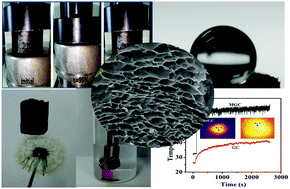Ultralight and highly compressible coal oxide-modified graphene aerogels for organic solvent absorption and light-to-heat conversion†
Abstract
The fabrication of high-performance graphene aerogels by economical and efficient routes is still a challenge. Herein, we prepared ultralight, highly elastic graphene/coal oxide (GC) aerogels with low-cost and simple routes, in which coal oxide was first introduced into the skeleton of graphene aerogels to prevent the severe stacking of graphene nanosheets. After the chemical grafting of the long carbon chains, the modified graphene/coal oxide (MGC) aerogels exhibited excellent hydrophobicity (140°). The ultralight MGC showed outstanding compression performance, recovering to about 100% with the compressive strain of 95% in a dry environment. Meanwhile, the optimized amount of coal oxide could also increase the absorption capacity of the aerogel by 196-fold. Moreover, the super-absorption capacity increased by up to 387 times its own mass via further carbonation treatment. Furthermore, the obtained MGC exhibited excellent absorption reusability in absorption/combustion cycles. Additionally, the MGC can be used as an interfacial solar vapor evaporator with an efficiency of 76% under 1 sun. On the basis of the viable synthesis method, the ultralight and compressive aerogels have promising applications in organic pollution cleanup and solar steam generation.



 Please wait while we load your content...
Please wait while we load your content...